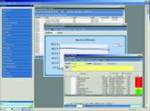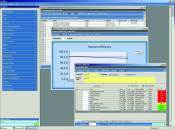Automating from Quote to Cash
Shop floor automation tools have the ability to take the concept of the interconnected shop to the next level—giving mold manufacturers technology to transform their business, enabling them to expand into new markets and new opportunities.
Many manufacturers have focused on automation to provide up-to-the-minute information for making sound business decisions. Traditional MRP and ERP systems have evolved to meet this demand for real-time data. But despite all of the automation that is available, employees are still gathering data on clipboards or manual time cards that is collected weekly, or worse, at the end of the job. This time lag and the potential for errors puts shops at a disadvantage because they cannot be proactive in problem solving. This means missed opportunities to address customer issues, production planning and scheduling problems, and cost or job profitability concerns.
Reaping the Rewards of Early Automation
Forward-thinking companies are pushing ERP beyond the manufacturing floor and integrating with other applications, according to a recent study by the Aberdeen Group. In fact, ERP has truly extended to every department in the automated shop. Shop foremen have real-time visibility into current activity for all employees. The office manager has timely and accurate information for regular payroll entries. And the shop owner and sales manager have insight into job status and cost information without getting up from their desk to go to the shop floor to find the job.
Your Next Automation Step
Suppliers of shop floor automation tools are collaborating to take the concept of the interconnected shop to the next level. Supported by a standard methodology and API, disparate systems can now work together to help a shop achieve efficiencies never dreamed of before.
For example, data collection directly into the ERP system can now be accomplished literally from the machine control. If the machine control is PC-based, any application that could only previously run on a desktop or laptop computer can now run seamlessly on the control itself. Machinists can log in to pull up their daily work assignments, which in turn, captures labor and machine costs automatically to the job. In addition, material can be issued directly from stock based on that transaction, which in turn, drives stock status and could alert the shop manager to any material shortages and many other important business management functions.
The next generation of this integration is likely to connect tooling systems that supply the machine. Imagine any machine tool being able to pass data back and forth to any tool management system and then in turn to the ERP system or inspection system. Tooling costs—especially the cost of perishable tooling—have traditionally been very difficult to capture. The ability to automatically capture data related to tooling usage means manufacturers can quickly glean important statistics for future capital investment needs.
With job information automatically updated to the ERP system from the shop floor, the schedule can be automatically updated with job projected end times that are based on actual machine cycle times instead of machine operator estimates. With this data, the ERP system can be used to assess and resolve under or overloaded shop work areas. So, no matter how much the job shop changes, the data presented is accurate and up-to-date. This frees manufacturers of scheduling inaccuracies.
Armed with this real-time data, a shop foreman can have visibility literally down to the minute on jobs that are running according to schedule, jobs that are running behind schedule, jobs that are waiting on material, work centers that are nearing capacity and work centers that are overloaded. Now, manufacturers at last have a means to proactively resolve impending bottlenecks and ensure customer promises are fulfilled.
Taking It to the Front Office
Manufacturers are now employing standard integration tools to make the concept of NED2 (never enter data twice) a reality. For example, businesses can gain a bi-directional flow of information between CAD and ERP solutions so that once the design and bill of material list is created on the CAD drawing when the customer orders, the job can be created in the ERP system with a complete bill of materials with no re-entry of data required. Likewise, the highly competitive nature of manufacturing has made it necessary to track everything from customer inquiries to marketing campaigns to prospective sales opportunities in the ERP system. Having seamless access between CRM and ERP systems means scheduling data is more reliable. Moreover, having real-time insight into sales forecasts captured in the CRM system aids managers in making more informed decisions about supply and staffing levels.
The Resiliency of Automated ERP
If ever there was proof that automation technology is transforming manufacturing as we know it, it is today’s financial situation. Even in this turbulent economy, we’re seeing manufacturers continue to invest in automation. According to a recent report by the Aberdeen Group, manufacturers who have embraced ERP technology have achieved significant return on their investment. In fact, they’ve been so successful that the top 20 percent of survey respondents said they were more likely to implement significantly more of their ERP functionality that they already possess and are significantly more likely to implement leading-edge technologies.
Summary
Manufacturers large and small are still investing in ERP technology. Yet the reason for doing so has changed. No longer are they willing to have ERP systems available to just administer the business or “run” the shop floor. They want technology to transform their business, enabling them to expand into new markets and new opportunities. The promise of a fully integrated business creates tremendous opportunities that were previously hidden within siloed systems. Ultimately, this results in manufacturers that are more agile, more proactive, and able to compete heartily with any shop in the world.
Related Content
The Benefits of Hand Scraping
Accuracy and flatness are two benefits of hand scraping that help improve machine loop stiffness, workpiece surface finish and component geometry.
Read MoreRevisiting Some Hot Runner Fundamentals
What exactly does a hot runner do? If you’ve been in the injection molding industry for any length of time, you might think the answer is obvious, but it is not.
Read MoreLaser Welding Versus Micro Welding
The latest battle in finely detailed restoration/repair of mold materials.
Read MoreMaintaining a Wire EDM Machine
To achieve the ultimate capability and level of productivity from your wire EDM on a consistent, repeatable and reliable basis, regular maintenance is a required task.
Read MoreRead Next
Improving Quality to Increase the Bottom Line
Prevention cost is one of the most significant elements of the cost of quality. When developing plans for reduction of quality expenditures, it is critical to analyze the various prevention costs during the product launch phase with a shop floor management system or ERP solution.
Read MoreAre You a Moldmaker Considering 3D Printing? Consider the 3D Printing Workshop at NPE2024
Presentations will cover 3D printing for mold tooling, material innovation, product development, bridge production and full-scale, high-volume additive manufacturing.
Read MoreReasons to Use Fiber Lasers for Mold Cleaning
Fiber lasers offer a simplicity, speed, control and portability, minimizing mold cleaning risks.
Read More











.jpg;maxWidth=300;quality=90)









